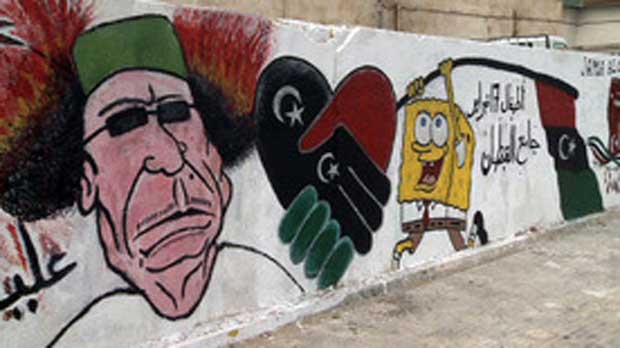 THUNDER BAY – The walls of buildings in Tripoli are far different today than they were only a few short months ago. Even though the fight to find and capture former the country’s former dictator are still on-going, and even though there are still battles in the country, artists are sending a message that things have changed in this African country. For Qadhafi – The writing is on the wall for former Libyan dictator.
THUNDER BAY – The walls of buildings in Tripoli are far different today than they were only a few short months ago. Even though the fight to find and capture former the country’s former dictator are still on-going, and even though there are still battles in the country, artists are sending a message that things have changed in this African country. For Qadhafi – The writing is on the wall for former Libyan dictator.
The international community under the North Atlantic Treaty Organization (NATO) are helping to protect the people of Libya. NATO is also reporting on how things are changing in the country.
Asked whether she’s ashamed of the graffiti covering the walls surrounding her, Khalida, an anaesthetist at one of the city’s hospitals, couldn’t be more certain. “It’s the other way around, it makes us more proud,” she says, “at least we are expressing ourselves and feel that changes are taking place.”
It might be seen as a blight in any other city of the world, but Tripolitans love the new colourful additions to their cityscape. This unexpected colour in this otherwise bleached urban landscape is part of a new dawn in the cultural life of Libya.
Concrete walls are now a blank canvas on which the bottled up creative expression of the city is being painted. The street art ranges from caricatures of Qadhafi as a rat or revolutionary slogans, through to utopian visions of the future for Libya with gleaming skyscrapers and families walking in the park. The dominant colours you see on the streets around are the red, green and black of the revolutionary flag.
The vast majority of the new art is political, slogans and imagery of the revolution that swept the city in August. “I’m Libyan…I’m Free,” declares one wall in letters a meter high, the words bursting with optimism. Others are simple stencils of one of the key images of this conflict, a pickup truck with a heavy machinegun on the back.
Artistic Revolution
During Qadhafi’s regime all writing or drawing in public spaces was banned. An artist could make good money painting portraits of the leader as a noble head of state but could never truly express their opinions with any freedom.
The artists behind this upsurge in creativity explain that these acts they are engaged in would have been unthinkable before. “If I drew these drawings while Qadhafi was still in power, I would’ve been executed as punishment, and my family would’ve been arrested or even killed too,” says Abdul, a law student at Tripoli’s university and artist.
For Libyan artists the revolution was an opportunity to throw off the tight binds that the regime imposed on their expression. “From the first day I started doing these paintings I felt like I had been born again,” says Abdul, “I had new life, me and all my neighbours who live in the area did, we have been through nothingness, and come through to the present.”
However, the art isn’t just political; often it is about remembering the sacrifices that have been made.
One mural in a quiet residential district lists the names of fighters killed in battles against Qadhafi loyalists. A strong arm holds the revolutionary flag over their neatly inscribed names. The faded paint applied months ago is side by side with fresher darker names indicating people killed more recently. Blank white space is still present on the wall, but it’s hoped it won’t be needed.
Looking to the future
Muhammad Al Zokar has brought western influences to his street art, a result of the time he spent in the Netherlands. He works with a spray gun in his baggy combat trousers and ‘No Fear’ t-shirt, listening to techno music on his MP3 player. Where some took up arms Muhammad took up his paint brush, expressing his hope for peace. “I don’t like to choose weapons because it harms people,” says Muhammad, “I like to see people dancing, being happy, singing, and people get married. Only happiness and love in our country.”
Muhammad, like many of the artists, likes to look to the future in his art, envisioning how his country might look ten years from now and hoping that the promise of a new start will turn into the bright future he hopes for. “I need something after Qadhafi from my point of view as a painter,” remarks Abdul, “I don’t want to go back to the era of injustice. We need freedom now after Qadhafi, new ideas, points of view and opinions after Qadhafi.”
Some of the art may be daubed slogans but much of it isn’t without aesthetic appeal. Promising technique and great skill abound. Admiring some art across from his shop where he sells women’s clothing Adel Mojan says, “I like these drawings, they are beautiful, you can feel the creativity in the paintings by the Libyan youth and their talent.”
These artists have brought a new sense of optimism to the streets of Tripoli in the wake of the revolution. They may not have contributed on the field of battle, but sometimes the pen is mightier than the sword.
“It’s art and makes you feel that we are liberated,” says a teenage girl called Lamis passing by, “the artists of Libya are doing something, even if it is a small step, they are doing something.”
